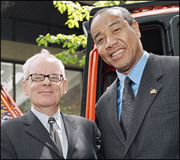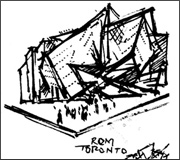 Name
Name
Inspired by the ROM's unique mandate - to build bridges of understanding and appreciation for the world's diverse cultures and precious natural environments - Michael Lee-Chin's extraordinary $30 million gift to the ROM is an act of both gratitude and hope: gratitude to this country for the opportunities it has given him and his family, and hope that his example might be an inspiration to young Canadians to act on their aspirations and become leaders in their own communities. The Michael Lee-Chin Crystal is named in recognition of his exceptional generosity and the remarkable vision behind his gift.
Brains
After an international search that attracted more than 50 firms, the Berlin-based Studio Daniel Libeskind was chosen in February 2002 to lead the Renaissance ROM team*. Born in Poland and raised in the US, Libeskind was a virtuoso musician before he studied architecture. He has designed buildings around the world, including the Jewish Museum in Berlin, the Danish Jewish Museum in Copenhagen and the Imperial War Museum North in Manchester.
 Napkin
Napkin
Inspired by the ROM’s gem and mineral collection, architect Daniel Libeskind sketched the initial concept on paper napkins while attending a family wedding at the ROM. The design was quickly dubbed the 'crystal' because of its crystalline shape.
"Why should one expect the new addition to the ROM to be 'business as usual'? Architecture in our time is no longer an introvert's business. On the contrary, the creation of communicative, stunning and unexpected architecture signals a bold re-awakening of the civic life of the museum and the city."
- Daniel Libeskind
Structure
The Lee-Chin Crystal is part of Renaissance ROM, the Museum's renovation and expansion project. Considered to be one of the most challenging construction projects in North America for its engineering complexity and innovative methods, the Lee-Chin Crystal is composed of five interlocking, self-supporting prismatic structures that co-exist but are not attached to the original ROM building, except for the bridges that link them.
Nuts and Bolts
The exterior is 25% glass and 75% extruded-brushed, aluminum-cladding strips in a warm silver colour. The steel beams, each unique in its design and manufacture and ranging from 1 to 25 metres in length, were lifted one by one to their specific angle, creating complicated angle joints, sloped walls, and gallery ceilings. Approximately 3,500 tons of steel and 38 tons of bolts were used to create the skeleton, and roughly 9,000 cubic metres of concrete were poured.
Opening Celebrations
It was a street party that Toronto will remember for years to come, and the perfect kickoff to the summer of 2007! On Saturday, June 2, the ROM, along with Their Excellencies The Right Honourable Michaëlle Jean, Governor-General of Canada and Mr. Jean-Daniel Lafond, officially opened the Michael Lee-Chin Crystal and marked the beginning of the Crystal Age for the ROM.
Luminaries, special guests and the excited crowd packed ROM Plaza, surrounding three concert stages set at the base of the Michael Lee-Chin Crystal. The evening began with a greeting by ROM Director and CEO William Thorsell. Revellers were then treated to an amazing 75-minute concert entitled A World of Possibilities, hosted by Paul Gross.
Kicking off the show was an energy-filled performance by Leahy and fiddler Natalie MacMaster, followed by Canadian Idol Eva Avila, Juno award-winning rap artist K’naan, Broadway star and R&B singer Deborah Cox and many more. Grammy-winning artist and composer David Foster unveiled a song he wrote especially for the evening, entitled We Can Build Anything. Audiences cheered as the song was performed by Canadian singer-songwriter Jann Arden, accompanied by a Canadian youth choir. The concert culminated in a dramatic lightshow that bathed the Lee-Chin Crystal in a spectrum of vibrant colours, against the backdrop of the Toronto skyline in the distance.
